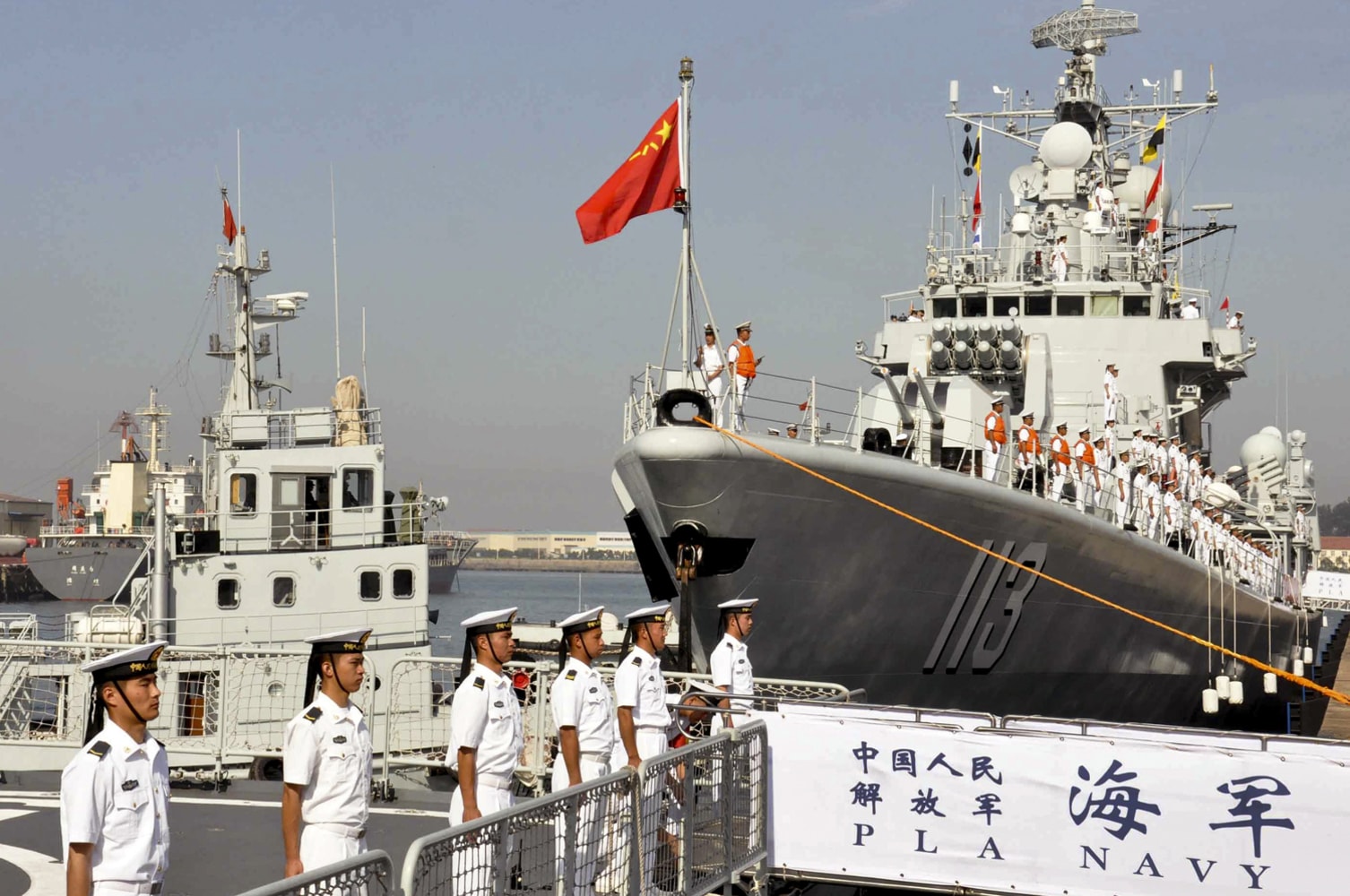The Military Base At The Heart Of US-China Rivalry

Table of Contents
Key US Military Bases in the Indo-Pacific and Their Strategic Importance
The United States maintains a significant military presence in the Indo-Pacific, utilizing a network of bases to project power and deter aggression. These bases are critical components of US strategy in countering China's growing influence.
Guam's Role as a Strategic Hub
Guam, a US territory in the western Pacific Ocean, serves as a crucial forward operating base. Its strategic location allows for rapid deployment of forces to the South China Sea, Taiwan, and other areas of potential conflict. Guam hosts significant assets of the US Navy and Air Force, including B-52 bombers, nuclear submarines, and advanced missile defense systems. The island's importance is amplified by its role as a staging area for potential operations and its ability to support air and naval power projection. Approximately 17,000 military personnel are stationed on Guam, making it a substantial military hub.
- Significant airbase: Guam's Andersen Air Force Base is capable of hosting a wide range of aircraft, including long-range bombers.
- Naval presence: The island supports significant naval deployments, including submarines and surface combatants.
- Missile defense systems: Guam is equipped with advanced missile defense systems to protect against potential threats.
Other Significant US Bases (e.g., Japan, South Korea, Philippines)
Beyond Guam, the US maintains a network of bases throughout the Indo-Pacific, further bolstering its military presence and strategic capabilities. These bases, located in countries like Japan, South Korea, and the Philippines, contribute significantly to the US military's power projection capabilities in the region. These partnerships, often solidified through formal alliances and security agreements, provide access to critical locations and logistical support networks, enhancing the overall strategic posture of the US military.
- Regional alliances: These bases are supported by strong alliances and agreements, ensuring cooperative security and access.
- Forward deployments: They allow for the forward deployment of troops and equipment, enabling quicker response times to crises.
- Intelligence gathering: They provide crucial platforms for intelligence gathering and surveillance in the region.
China's Expanding Military Infrastructure and Its Implications
China's military modernization program is a key driver of the escalating US-China rivalry. The expansion of its military infrastructure, particularly in the South China Sea, presents a direct challenge to US interests and regional stability.
Artificial Island Bases in the South China Sea
China's construction of artificial islands in the South China Sea has significantly altered the geopolitical landscape. These islands are equipped with military airfields, harbors, and sophisticated missile defense systems, enabling China to project power and assert its claims in the region. This has sparked international condemnation due to the violation of international law and its potential to destabilize the region. The creation of these bases directly impacts freedom of navigation and regional security, potentially leading to increased tensions and the risk of conflict.
- Military airfields: These artificial islands are equipped with airfields capable of hosting fighter jets and bombers.
- Harbors: They provide shelter for naval vessels and submarines, increasing China's maritime power projection.
- Missile defense systems: The islands are fortified with missile systems, significantly enhancing their defensive and offensive capabilities.
Other Key Chinese Military Bases and Installations
Beyond the South China Sea, China is modernizing and expanding its military bases and installations across its territory. This includes significant investments in its navy, air force, and cyber warfare capabilities, leading to an increasingly assertive military posture and a shift in the regional balance of power. The implications for regional stability are significant, heightening concerns about potential conflicts and the need for careful diplomatic engagement.
- Modernization efforts: China's continuous military modernization efforts pose a significant challenge to regional security.
- Increased naval power: The expansion of China's navy gives it greater reach and influence in the Indo-Pacific.
- Cyber warfare capabilities: China’s growing cyber warfare capabilities further increase the complexity of the strategic competition.
The Impact on Regional Stability and Global Power Dynamics
The concentration of military bases in the Indo-Pacific significantly impacts regional stability and global power dynamics. The heightened military presence increases the risk of miscalculation and escalations, while the economic and trade implications of the rivalry are equally significant.
Increased Risk of Miscalculation and Escalation
The increasing military presence of both the US and China in the Indo-Pacific significantly elevates the risk of accidental conflict or miscalculation. The potential consequences of a military clash in the region would be severe, with far-reaching global implications. Therefore, diplomacy and de-escalation strategies are paramount to mitigate this risk. Open communication channels and confidence-building measures are crucial in preventing unintended escalation.
- Risk of conflict: The close proximity of military forces increases the risk of accidental clashes or unintended escalation.
- Potential for escalation: Any incident could rapidly escalate due to the complex geopolitical dynamics and the sensitivity of the region.
- Importance of communication: Clear communication channels and diplomatic efforts are critical to manage risks and prevent escalation.
Economic and Trade Implications
The US-China rivalry significantly impacts regional trade and investment. The South China Sea, a crucial waterway for global shipping, is particularly vulnerable. Disruptions to shipping lanes in this region could have devastating consequences for global supply chains and the world economy. The potential for economic sanctions and trade wars further exacerbates these risks, creating a complex interplay of economic and security concerns.
- Trade routes: The South China Sea is a vital trade route, making it a critical point of contention.
- Economic sanctions: The potential for economic sanctions adds another layer of complexity to the existing tensions.
- Supply chain vulnerabilities: Disruptions to shipping lanes could severely impact global supply chains and economic stability.
Conclusion
The intense US-China rivalry, deeply rooted in the strategic positioning of military bases across the Indo-Pacific, significantly impacts regional stability and global power dynamics. The escalating military buildup and the potential for miscalculation demand careful diplomatic engagement and proactive de-escalation strategies. The complex interplay between these military bases highlights the critical need for understanding the geopolitical landscape.
Call to Action: Understanding the complex interplay of military bases in the ongoing US-China rivalry is crucial for navigating the geopolitical landscape. Further research into the specific locations, capabilities, and strategic implications of these bases is vital to comprehend the evolving dynamics and potential risks associated with this critical geopolitical hotspot. Continue to learn more about the role of military bases in the US-China rivalry and stay informed on this crucial issue.

Featured Posts
-
 Anchor Brewing Company Closes After 127 Years The End Of An Era
Apr 26, 2025
Anchor Brewing Company Closes After 127 Years The End Of An Era
Apr 26, 2025 -
 Los Angeles Wildfires And The Gambling Industry A Concerning Connection
Apr 26, 2025
Los Angeles Wildfires And The Gambling Industry A Concerning Connection
Apr 26, 2025 -
 Will Chinese Vehicles Dominate The Global Car Market
Apr 26, 2025
Will Chinese Vehicles Dominate The Global Car Market
Apr 26, 2025 -
 Karen Read A Chronological Overview Of Legal Proceedings
Apr 26, 2025
Karen Read A Chronological Overview Of Legal Proceedings
Apr 26, 2025 -
 Bof As Argument Against Stock Market Valuation Concerns
Apr 26, 2025
Bof As Argument Against Stock Market Valuation Concerns
Apr 26, 2025
